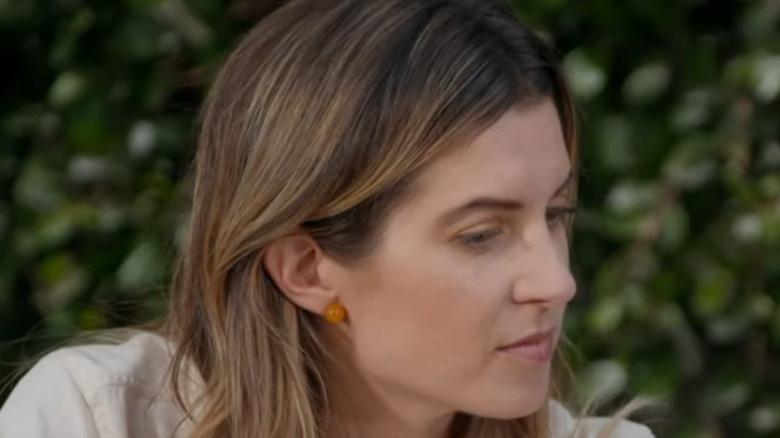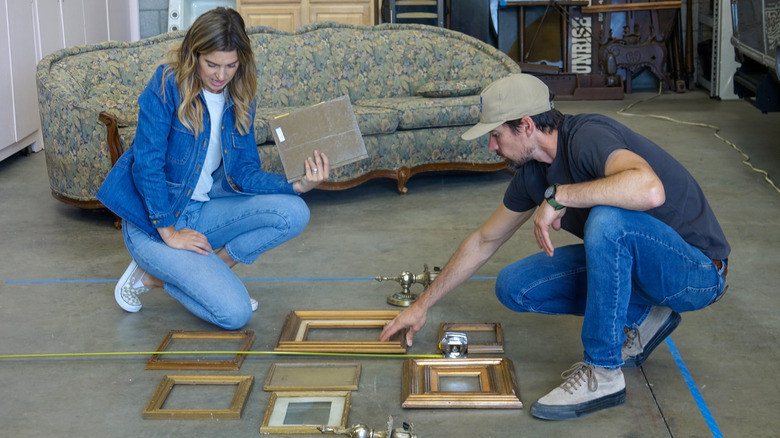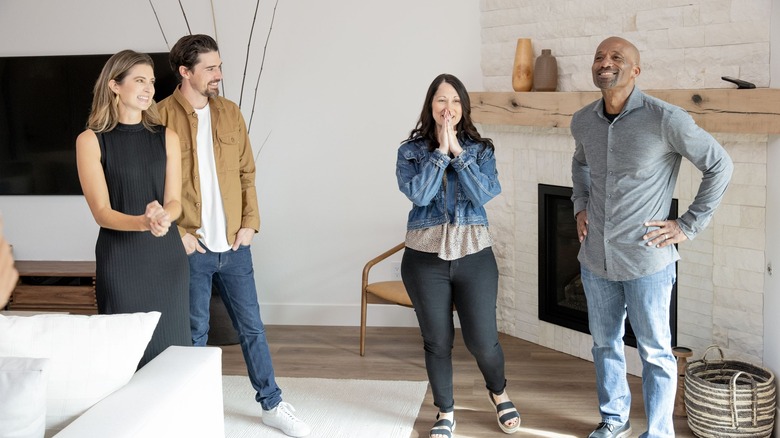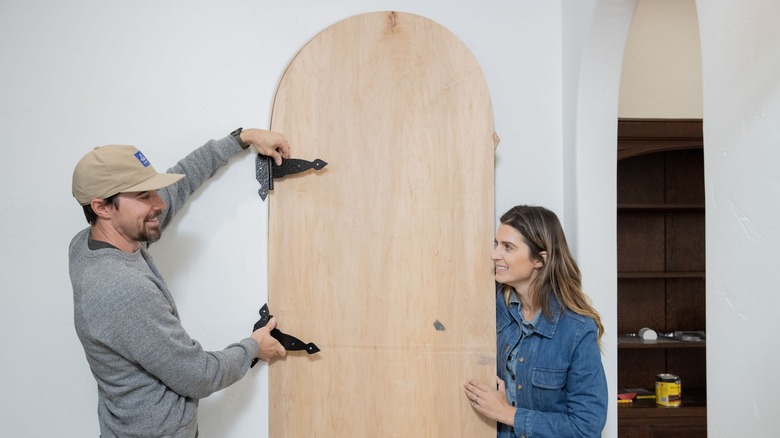Kele Dobrinski And Christina Valencia Preview HGTV's Mash Up Our Home - Exclusive Interview
Every relationship requires compromises. Whether it's deciding what movie to see or what to name your kids, it's inevitable that couples will run into situations in which their first choices don't match, and one or both of them will have to settle for an option they don't totally love. Some compromises are easier to live with than others. Settling for pizza when you were really craving tacos is no big deal — it's just one meal, and you can still have a good time. What if the choice the two of you disagree on is not only something you will have to live with every day, but a central part of your personal image and lifestyle — like the appearance of your home?
This is the premise of the new HGTV show "Mash Up Our Home." In the show, married designers Kele Dobrinski and Christina Valencia work with couples with two distinct — and potentially clashing — design visions and brainstorm with them to devise a harmonious look that celebrates both of their visions. As one can imagine, this is a challenging mission, requiring not only out-of-the-box design thinking but the listening and diplomatic skills of a marriage counselor. In this exclusive interview, Dobrinski and Valencia share how the show came to be and their secrets for great design.
Their backgrounds in communications and storytelling inspired MUOH
First, how did you get the idea for the show?
Christina Valencia: Kele and I have been doing our design business for four years. Before that, we were in different disciplines, actually, of storytelling. Kele was in advertising and I was in communications. We've always really been interested in creating a strong concept from the beginning and having it be differentiated. That idea of not relying on one genre is something that we've always pulled from as we've started to move into these physical spaces.
Kele Dobrinski: We had traditionally come from a branding background, and I think having a strong concept that you lean into from the get-go has always been really important to the creative work that we do. As we steered into residential work, we only knew how to work that same way. We try to do as much research as we can on our clients and put together a strong concept. That's how this mashup idea was like putting a nice bow on the strategic direction and conceptual work that we'd always done.
Valencia: That's the design side of it. Obviously, from the people side of it, in our experience outside of the show and before the show, no two people living together have the same design sensibilities. Even if you're aligned, you're a different human being, so you're bringing two different ideas to the table. Innately, it's a problem that everyone has, and finding a middle ground is really something that happens in all of our work.
How did HGTV find you or how did you find them?
Valencia: They actually found us. We posted something about a cabin we had done up in Lake Tahoe, and one of the bathroom tile patterns we used was a duotone pattern that was modeled after a 1970s ski glove that Kele found online. We had done a writeup in Apartment Therapy, and one of the producers from the production company read about that and wanted to reach out and hear more.
What was the toughest mashup challenge that you have had to deal with?
Dobrinski: What would you say? I mean, I think the hardest one ... A lot of times we do a lot of research up front and we actually walk through the home separately with each homeowner. Whether it's a husband and wife or whether it's a family or a joint family, we'll split up and we try and do that to get as much information as we can. In going through that, we try and learn, "What are the styles? What is the taste? What are their color palettes or color palettes that they don't love? How do we get as much information as we can?"
A lot of times, it doesn't yield a completely clear direction. For me, I would say that the hardest one was, we had one that the concept was called "bright harmony." We ended up in this place where you don't have something like mid-century, or you don't have farmhouse, some type of style that is clear and cut and dried. For us, it was developing an interesting concept that felt like we were bringing these two homeowners together through a ...
Valencia: A feeling really.
Dobrinski: A feeling, yeah.
Dobrinski and Valencia share how they learned to combine their own personal styles
What has been your favorite project so far?
Valencia: For me, we did one for a multi-generational family moving from Southern California to Northern California. It's our California cottage. It's not often that we've been able to design for parents and grown children that were going to be living under one roof. And the home was really unique because it had two A-frame living rooms. We were able to really dive into each of their styles in their individual living rooms, but then find cohesion in their shared spaces. I love that we pulled from the geography of Southern California to Northern California. Kele and I are both born-and-raised Californians, so it felt very fun and real to who we were.
What are your personal favorite styles?
Valencia: Oh man, it changes every day. If you're asking my fashion style, it's denim on denim.
Dobrinski: Man, it really does. I think there's some threads that come through and everything. We do like to bring in a lot of color and liveliness in the spaces.
Valencia: Yeah, we had the opportunity with our own home to do kind of a modern Spanish home. And one of the homes on the show also has a mission California feel to it. And I think that again, probably because I've lived in California most of my life outside of my stint in New York, that feeling, the Santa Barbara, California feeling, lots of tile, lots of really comfortable, casual, welcoming feeling is something that I gravitate towards.
Do you guys have the same styles? And if not, how do you combine them in your own lives?
Valencia Well, we've been together for 15 years, so they've started to meld.
Dobrinski: At some point, the lines get a little blurred, but ... I do typically lean probably a little bit more modern, a little bit more clean. I like a clean, tidy house where there's a place for everything. You would probably go a little bit more –
Valencia: More color, more texture, definitely a little more variety versus you. When you're working with two people, you decide what you can live with and what you want to really hold tight to. So there's some design decisions ... we did it with our own house. This was our own experiment and we were able to find a blended style for the two of us to live [with]. That's why we realized we could probably do it for other people. It is figuring out ... I really, really, really want this tile on this backsplash, but maybe I can give in a little bit for something else and have really clean lines in another space.
They have helpful tips for couples wanting to redecorate their homes
That brings me up to my next questions — what are some of your secrets for combining styles effectively?
Valencia: The big thing is that we try to dive a little deeper than the surface level to find commonalities. There are commonalities between everyone too, but if you start to talk to someone and [in] the first five minutes, they're like, "Oh, their style is just so wildly different. I can't figure out how to justify where that commonality is." They're living together for a reason. They have a shared relationship for a reason. Our goal is to really spend a lot of time listening at the beginning to find where that commonality lies.
What advice would you give couples wanting to redecorate their spaces?
Dobrinski: Part of it is understanding how someone lives and being able to take a step back. This is where I think we do bring perspective here, but anyone can also look at their own lives and look at the things that may bring them stress or anxiety. [For] a lot of people, we walked into their house and it felt like a very chaotic space because their house maybe wasn't tidy or there were colors all over the place. That may not be because ... they want everything perfectly clean and stark and it may not be because they hate color. I think it's finding a balance. How do you change your behaviors in your own life and build/design a house around that? Adding more storage space, finding ways to choose the colors that you want in your space and make sure those colors are cohesive, but it may not be getting rid of color entirely. Finding those balances is really important.
Valencia: Another thing on that, when someone's looking to think about their style is to really, like Kele's saying, think about how you really want to live and what speaks to you. Don't let the 12 genres that are out there define what you think you want to be. We've been able to be fortunate on the show to really flex that muscle and create things that don't really exist within a genre that people think of. Create your own style if that's what you like.
Finally, what are some of your favorite home improvement shows right now?
Valencia: Oh man, we have three kids, so we don't get to watch too much TV. I was such a big fan of the Fords when they were on. Leanne's a big inspiration for me, so it's really fun to watch what everyone's up to. You can get inspiration from anywhere, and it's really cool to see how HGTV has really flexed into the home inspection process. Even though that's not glamorous, it's super important if you're going to be a homeowner, down to looking at how people in different cities are living and stuff. We get inspiration from everywhere.
Mash-Up Our Home premieres Saturday, March 12, at 8 p.m. ET/PT on HGTV.



